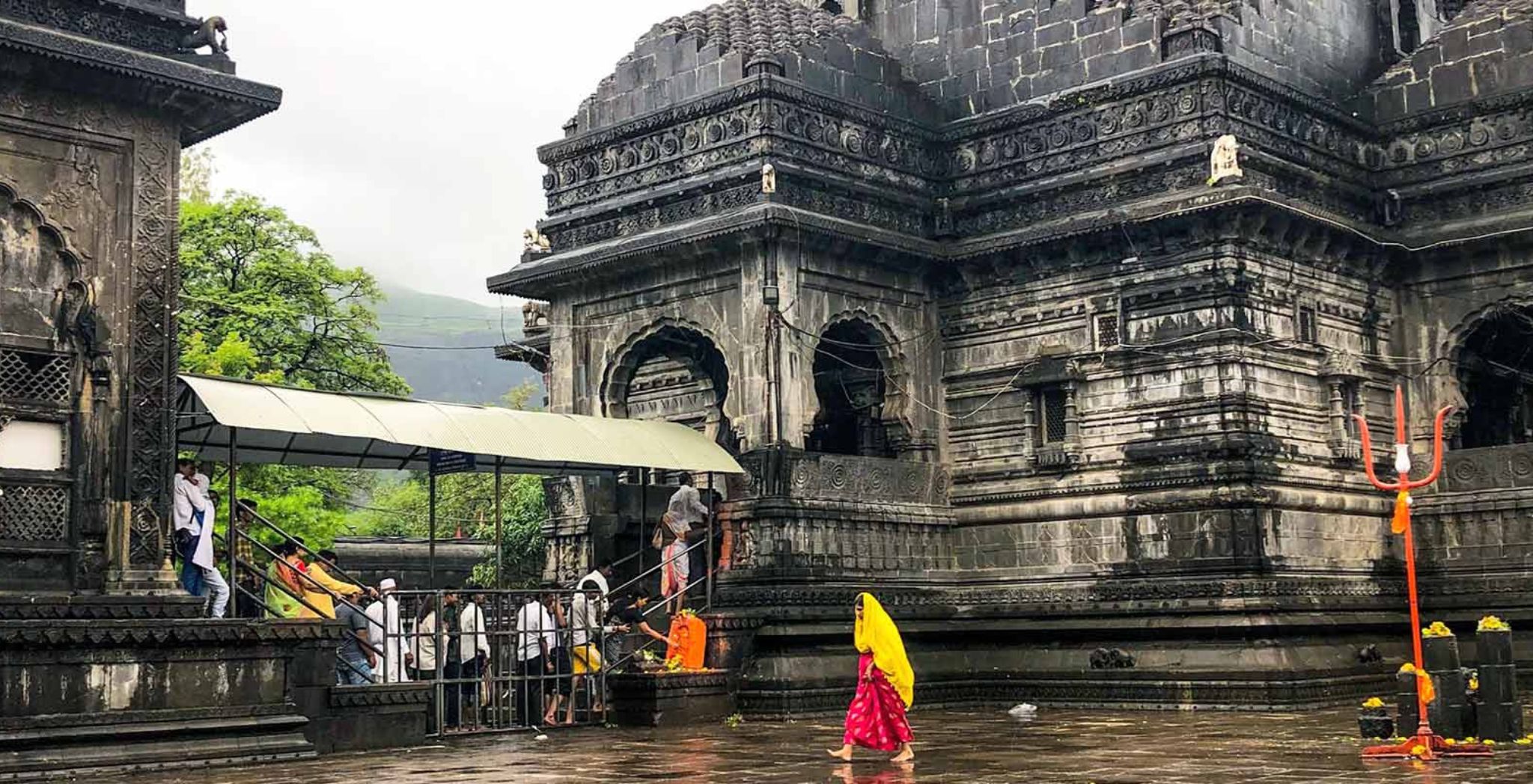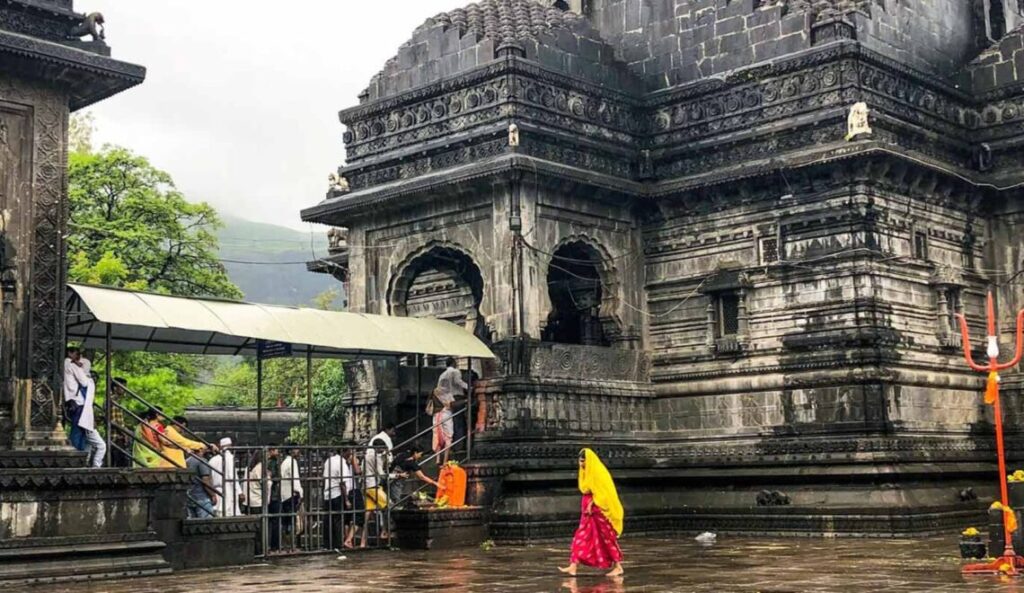The Trimbakeshwar Temple, located in Trimbak in the Nashik district of Maharashtra, India, stands as one of the most esteemed temples devoted to Lord Shiva.
However, it has gained renown for its rich history, unique architectural style, and profound religious significance.
1. History Behind the Trimbakeshwar Temple

The history behind the Trimbakeshwar Temple has deep roots in Hindu mythology and ancient scriptures, weaving together tales of devotion, divine intervention, and spiritual significance.
Legend says that the Trimbakeshwar Temple sits at the source of the Godavari River, one of Hinduism’s holiest rivers. Moreover, the temple’s origins trace back to the sage Gautama Maharishi, a revered figure in Hindu mythology renowned for his devotion to Lord Shiva.
Legend has it that Gautama Maharishi and his wife Ahalya resided in the area where the temple now stands. However, they faced a severe drought, leading Gautama Maharishi to perform intense penance and prayers to Lord Shiva for relief.
Additionally, pleased with his devotion, Lord Shiva appeared before him. He granted his wish, causing the sacred Godavari River to emerge from the Brahmagiri hills, thus providing water to the parched land.
Gautama Maharishi is believed to have requested Lord Shiva to stay in the form of a lingam (a symbol of divine energy) at the site of the emerging river, thus establishing the Trimbakeshwar Jyotirlinga. However, people worship this lingam as Lord Trimbakeshwar, the temple’s presiding deity.
Another significant legend associated with the temple involves the curse of the sage Gautama on the Godavari River. Once, while bathing in the river, Gautama encountered a cow, a tiger, and a serpent, all drinking water from the same spot. Moreover, Gautama cursed the river out of anger, causing it to dry up.
However, after realizing his curse’s severity, he repented and prayed for forgiveness. Lord Shiva, moved by his devotion, forgave him and allowed the river to flow again.
The Trimbakeshwar temple’s history mirrors the profound spiritual bond between humanity and the divine, highlighting the lasting strength of faith and devotion. Furthermore, it continues to be a place of pilgrimage and worship for millions of devotees, who come to seek blessings, perform rituals, and immerse themselves in the sacred atmosphere of this ancient temple.
2. The Birth of the Temple

However, the genesis of the Trimbakeshwar Temple is steeped in ancient mythology and revered tales of divine intervention. According to Hindu scriptures and local folklore, the temple’s origin lies in the sacred relationship between the revered sage Gautama Maharishi and Shiva Jyotirlinga in Maharashtra.
Legend has it that Gautama Maharishi and his wife Ahalya resided in the region where the temple stands today. However, the area faced a severe drought, leaving its inhabitants parched and desperate for water. Moreover, in response to the crisis, Gautama Maharishi embarked on a profound journey of penance and devotion, seeking divine intervention to alleviate the people’s suffering.
Impressed by Gautama’s unwavering dedication, Lord Shiva, the supreme deity of the Hindu pantheon, appeared before him in the form of a lingam (a symbolic representation of divine energy). However, moved by Gautama’s prayers and the plight of the people, Lord Shiva granted his wish and caused the sacred Godavari River to emerge from the Brahmagiri hills, blessing the land with the precious gift of water.
In gratitude for this divine intervention, Gautama Maharishi expressed his desire to establish a temple at the source of the Godavari River, dedicated to Lord Shiva in his manifestation as Trimbakeshwar, the lord of the three sacred rivers – Godavari, Ganga, and Saraswati.
Guided by his spiritual vision and devotion, Gautama Maharishi laid the foundation of the Trimbakeshwar Temple, symbolizing the eternal bond between humanity and the divine. His son, Shri Pundalik, later completed the temple’s construction, ensuring that future generations could continue to pay homage to Lord Trimbakeshwar and seek solace in his divine presence.
Thus, the Trimbakeshwar Temple stands as a testament to the enduring legacy of devotion and faith, serving as a beacon of spiritual enlightenment and a sanctuary for countless devotees who flock to its hallowed halls to seek blessings, offer prayers, and partake in the trimbakeshwar temple timings traditions of Hindu worship.
3. Architectural Significance

The Trimbakeshwar Temple is renowned for its distinctive architectural style, which is a testament to the artistic brilliance of ancient Indian artisans. The temple follows the Hemadpanthi architectural style, characteristic of the Yadava dynasty’s era in Maharashtra.
One of the temple’s most striking features is its towering spire, adorned with intricate carvings and sculptures depicting various mythological figures and motifs. The temple’s exterior is decorated with ornate designs, reflecting the grandeur and beauty of Hindu temple architecture.
Inside, the temple boasts beautifully carved pillars and ceilings, creating a mesmerizing ambiance that transports visitors to a bygone era of spiritual splendor. The architectural detailing, from the majestic entrance to the sanctum sanctorum housing the lingam of Lord Trimbakeshwar, exudes a sense of divine presence and reverence.
The Trimbakeshwar Temple is architecturally significant due to its captivating beauty and power to evoke awe and devotion in visitors, solidifying its status as a revered cultural and religious icon in the area.
4. Timings of the Temple

The Trimbakeshwar Temple is open to devotees from early morning to late evening. For the most up-to-date information on changes to the Trimbakeshwar Temple’s operating hours during special events and festivals, we recommend visiting the temple’s official website or contacting the temple authorities.
a) Poojas and Ceremonies
The Trimbakeshwar Temple’s renown stems from its diverse and elaborate poojas (religious rituals) and ceremonies, each holding significance and purpose in Hindu tradition. These rituals, conducted with utmost devotion and reverence, attract devotees from far and wide who seek blessings, protection, and spiritual fulfillment.
b) Kaal Sarp Pooja
This pooja is performed to alleviate the effects of the Kaal Sarp Dosha, a belief in Hindu astrology that suggests malefic planetary positions causing obstacles and challenges in one’s life. Devotees undertake this pooja to seek relief from the adverse effects and to attain peace and prosperity.
c) Narayan Nagbali Pooja
This pooja is performed to appease the souls of deceased ancestors (Pitrus) who may be experiencing unrest or dissatisfaction. By performing specific rituals, including offerings to Lord Narayan (Vishnu) and performing Nagbali, devotees seek solace to their departed ancestors and ensure their smooth transition to the afterlife.
d) Tripindi Shradha Pooja
This pooja is dedicated to honoring and paying homage to one’s ancestors (Pitrus) by offering prayers and performing rituals on their behalf. Performing Tripindi Shradha is believed to absolve the Pitrus of any past sins and grant them peace and liberation.
e) Mahamrityunjaya Pooja
This sacred ritual invokes Lord Shiva’s blessings in his form as Mahamrityunjaya, the vanquisher of death. Devotees undertake this pooja to attain protection from illness, accidents, and untimely death and to promote health, longevity, and overall well-being.
f) Rudrabhishek
This elaborate pooja involves the chanting of Vedic mantras and the offering of various items such as milk, honey, yogurt, ghee, and flowers to Lord Shiva in his form as Rudra, the fierce aspect of the divine. Performing Rudrabhishek attracts the blessings of Lord Shiva, fostering prosperity, success, and spiritual development.
g) Laghu Rudrabhishek
Similar to Rudrabhishek, this pooja is shorter and has fewer rituals and offerings. Devotees who seek Lord Shiva’s blessings but have limited time or resources often conduct it.
These poojas and ceremonies form an integral part of the spiritual experience at the Trimbakeshwar Temple, offering devotees the opportunity to connect with the divine, seek blessings for themselves and their loved ones, and partake in ancient traditions passed down through generations.
Conclusion
The Trimbakeshwar Temple is not only a place of worship but also a profound symbol of India’s vibrant cultural and religious legacy. Its historical depth, mythological significance, and architectural grandeur render it an essential destination for both devotees and tourists. The temple’s tranquil environment and spiritual atmosphere provide a peaceful sanctuary for those in search of solace and divine blessings.
FAQ
Q: What are the Trimbakeshwar Temple timings?
A: The Trimbakeshwar Temple is open to devotees from early morning to late evening. However, timings may vary on special occasions and during festivals, so verify the latest information by visiting the temple’s official website or contacting the authorities directly.
Q: How far is the Trimbakeshwar Temple from Shirdi?
A: The distance between Trimbakeshwar temple and Shirdi is approximately. The travel time may vary depending on the mode of transportation chosen.
Q: Where can I find photos of the Trimbakeshwar Temple?
A: You can find photos of the Trimbakeshwar Temple on various travel websites, social media platforms, and the temple’s official website. These photos showcase the temple’s architectural beauty and its serene surroundings.
Q: What is the significance of the Trimbakeshwar Temple?
A: The Trimbakeshwar Temple holds significance for Hindus because they believe it is the source of the Godavari River. It is also one of the twelve Jyotirlingas, considered Lord Shiva’s most sacred abodes.
Q: What are some poojas and ceremonies performed at the Trimbakeshwar Temple?
A: The Trimbakeshwar Temple is famous for its elaborate poojas and ceremonies, which devotees perform to seek Lord Shiva’s blessings.
Some of the critical poojas and ceremonies include the Kaal Sarp Pooja, Narayan Nagbali Pooja, Tripindi Shradha Pooja, Mahamrityunjaya Pooja, Rudrabhishek, and Laghu Rudrabhishek. People believe these rituals bring the devotees peace, prosperity, and success.
Q: Can you provide more information on the architectural significance of the Trimbakeshwar Temple?
A: The Trimbakeshwar Temple, known for its unique Hemadpanthi architectural style, has a towering spire, intricate carvings, and beautiful sculptures.
This architectural style typifies many temples built in Maharashtra during the Yadava dynasty’s reign and reflects the region’s rich cultural heritage.










